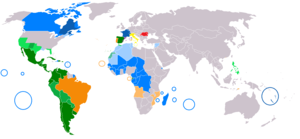Neolatine language
| Romance | |
|---|---|
| Ethnicity | Latin peoples |
| Geographic distribution |
Originated in coastal Mediterranean and western Europe; now also spoken all over the Americas, much of Africa and in parts of Southeast Asia and Oceania |
| Linguistic classification |
Indo-European
|
|
Early form
|
|
| Subdivisions | |
| ISO 639-2 / 5 | |
| Linguasphere | 51- (phylozone) |
| Glottolog | roma1334 |
 |
|
 |
|
The Romance languages (sometimes called the Romanic languages, Latin languages, or Neo-Latin languages) are the modern languages that evolved from Vulgar Latin between the sixth and ninth centuries and that thus form a branch of the Italic languages within the Indo-European language family.
Today, around 800 million people are native speakers worldwide, mainly in Europe, Africa and the Americas, but also elsewhere. Additionally, the major Romance languages have many non-native speakers and are in widespread use as lingua francas. This is especially the case for French, which is in widespread use throughout Central and West Africa, Madagascar, Mauritius and the Maghreb.
The five most widely spoken Romance languages by number of native speakers are Spanish (410 million), Portuguese (250 million), French (80 million), Italian (60 million), and Romanian (25 million).
Because of the difficulty of imposing boundaries on a continuum, various counts of the modern Romance languages are given; for example, Dalby lists 23 based on mutual intelligibility. The following, more extensive list, includes 35 current, living languages, and one recently extinct language, Dalmatian:
Romance languages are the continuation of Vulgar Latin, the popular and colloquial sociolect of Latin spoken by soldiers, settlers, and merchants of the Roman Empire, as distinguished from the classical form of the language spoken by the Roman upper classes, the form in which the language was generally written. Between 350 BC and 150 AD, the expansion of the Empire, together with its administrative and educational policies, made Latin the dominant native language in continental Western Europe. Latin also exerted a strong influence in southeastern Britain, the Roman province of Africa, western Germany, Pannonia and the Balkans north of the Jireček Line.
...
Wikipedia
